1998 PONTIAC BONNEVILLE inflation pressure
[x] Cancel search: inflation pressurePage 202 of 395
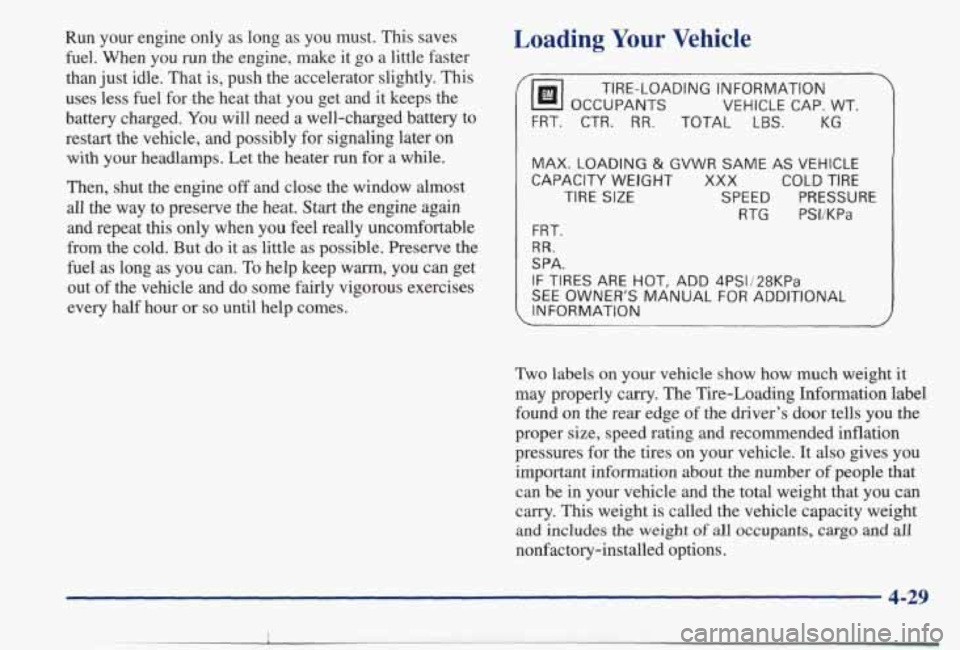
Run your engine only as long as you must. This saves fuel. When you run the engine, make it go a little faster
than just idle. That is, push the accelerator slightly. This
uses less fuel for .the heat that you get and it keeps the
battery charged. You will need
a well-charged battery to
restart the vehicle, and possibly for signaling later on
with your headlamps. Let the heater run for a while.
Then, shut the engine
off and close the window almost
all the way to preserve the heat. Start the engine again and repeat this only when you feel really uncomfortable
from the cold. But do
it as little as possible. Preserve the
fuel as long as you can. To help keep warm, you can get
out
of the vehicle and do some fairly vigorous exercises
every half hour
or so until help comes.
Loading Your Vehicle
;"
7
TIRE-LOADING INFORMATION
OCCUPANTS
VEHICLE CAP. WT.
FRT. CTR.
RR. TOTAL LBS. KG
MAX. LOADING & GVWR SAME AS VEHICLE
CAPACITY WEIGHT
XXX COLD TIRE
TIRE SIZE SPEED PRESSURE
RTG PSVKPa
FRT.
RR.
SPA.
IF TIRES ARE HOT, ADD 4PS1/28KPa
SEE OWNER'S MANUAL FOR ADDITIONAL
, INFORMATION
Two labels on your vehicle show how much weight it
may properly carry. The Tire-Loading Information label
found on
the rear edge of the driver's door tells you the
proper size, speed rating and recommended inflation
pressures for the tires on your vehicle. It also gives you
important information about the number
of people that
can be in your vehicle and the total weight that you can
carry. This weight is called the vehicle capacity weight
and includes the weight of all occupants, cargo and all
nonfactory-installed options.
4-29
Page 250 of 395
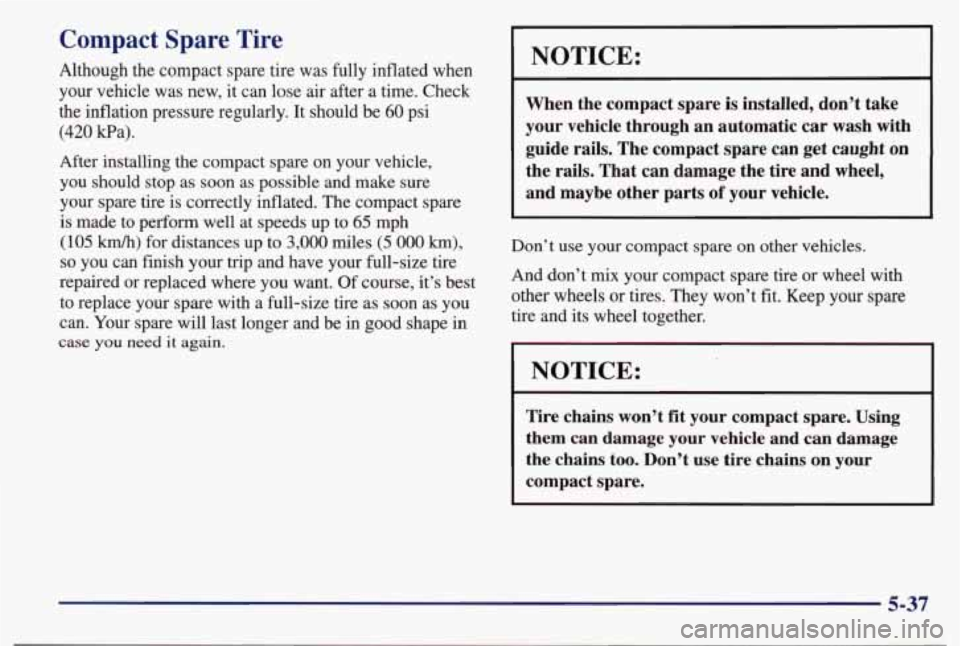
Compact Spare Tire
Although the compact spare tire was fully inflated when
your vehicle was new, it can lose
air after a time. Check
the inflation pressure regularly. It should be
60 psi
(420 Wa).
After installing the compact spare on your vehicle,
you should stop as soon
as possible and make sure
your spare tire is correctly inflated. The compact spare
is made to perform well at speeds up to 65 mph
(105 km/h) for distances up to 3,000 miles (5 000 km),
so you can finish your trip and have your full-size tire
repaired or replaced where you want. Of course, it’s best
to replace your spare with a full-size
tire as soon as you
can. Your spare will last longer and be in good shape in
case you need it again.
NOTICE:
When the compact spare is installed, don’t take
your vehicle through an automatic car wash with
guide rails. The compact spare can
get caught on
the rails. That can damage the tire and wheel,
and maybe other parts
of your vehicle.
Don’t use your compact spare on other vehicles.
And don’t mix your compact spare tire
or wheel with
other wheels or tires. They won’t fit. Keep your spare
tire and its wheel together.
NOTICE:
Tire chains won’t fit your compact spare. Using
them can damage your vehicle and can damage
the chains too. Don’t use tire chains on your
compact spare.
5-37
Page 292 of 395
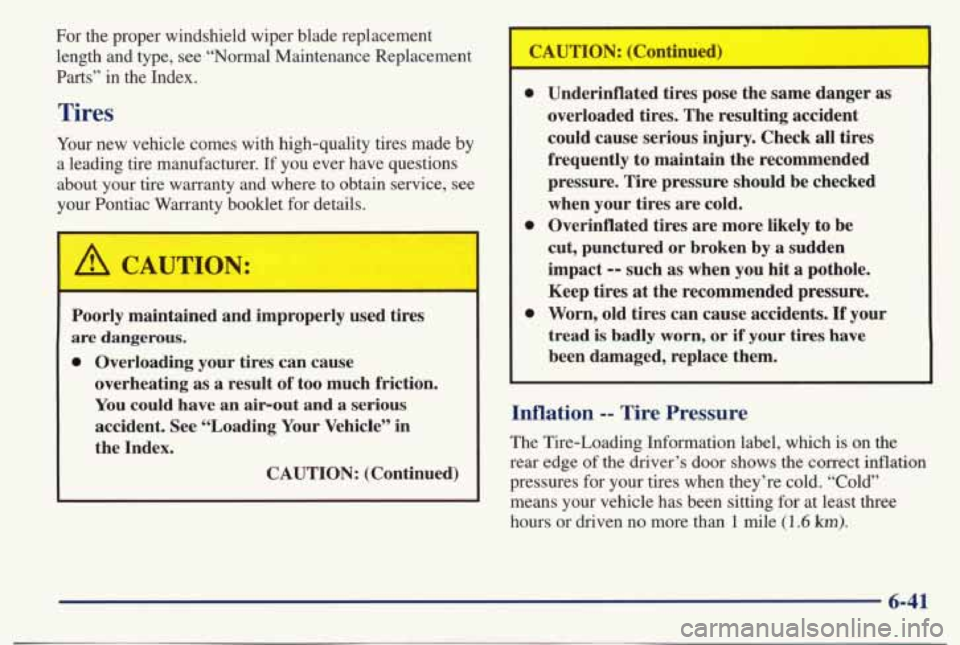
For the proper windshield wiper blade replacement length and type, see “Normal Maintenance Replacement
Parts” in the Index.
Tires
Your new vehicle comes with high-quality tires made by
a leading tire manufacturer. If you ever have questions
about your tire warranty and where to obtain service, see
your Pontiac Warranty booklet for details.
Poorly maintained and improperly used tires
are dangerous.
0 Overloading your tires can cause
overheating as a result of too much friction.
You could have an airout and a serious
accident. See “Loading Your Vehicle” in
the Index.
CAUTION: (Continued)
0
a
0
Underinflated tires pose the same danger as
overloaded tires. The resulting accident
could cause serious injury. Check
all tires
frequently to maintain the recommended
pressure. Tire pressure should be checked when your tires are cold.
Overinflated tires are more likely to be
cut, punctured or broken
by a sudden
impact
-- such as when you hit a pothole.
Keep tires
at the recommended pressure.
Worn, old tires can cause accidents.
If your
tread
is badly worn, or if your tires have
been damaged, replace them.
Inflation -- Tire Pressure
The Tire-Loading Information label, which is on the
rear edge
of the driver’s door shows the correct inflation
pressures for your tires when they’re cold. “Cold”
means your vehicle has been sitting for at least three
hours or driven no more than
1 mile (1.6 km).
6-41
Page 293 of 395
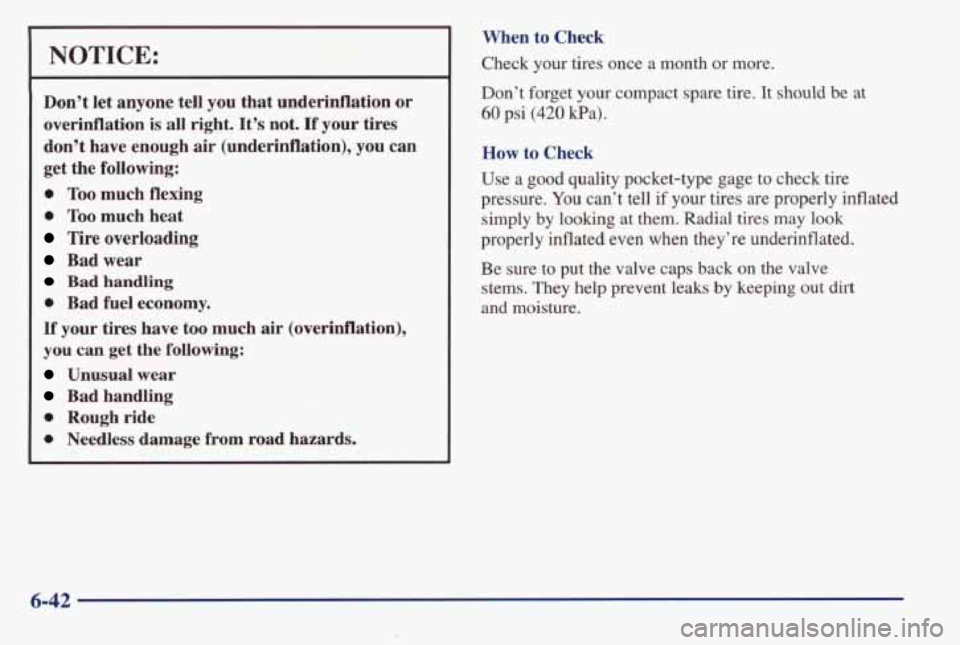
NOTICE:
Don’t let anyone tell you that underinflation or
overinflation is
all right. It’s not. If your tires
don’t have enough air (underinflation),
you can
get the following:
0 Too much flexing
0 Too much heat
Tire overloading
Bad wear
Bad handling
0 Bad fuel economy.
If your tires have too much air (overinflation),
you can get the following:
Unusual wear
Bad handling
0 Rough ride
0 Needless damage from road hazards. When
to Check
Check your tires once a month or more.
Don’t forget your compact spare tire. It should
be at
60 psi (420 Wa).
How to Check
Use a good quality pocket-type gage to check tire
pressure.
You can’t tell if your tires are properly inflated
simply by looking at them. Radial tires may look
properly inflated even when they’re underinflated.
Be sure to put the valve caps back on the valve
stems.
They help prevent leaks by keeping out dirt
and moisture.
6-42
Page 294 of 395
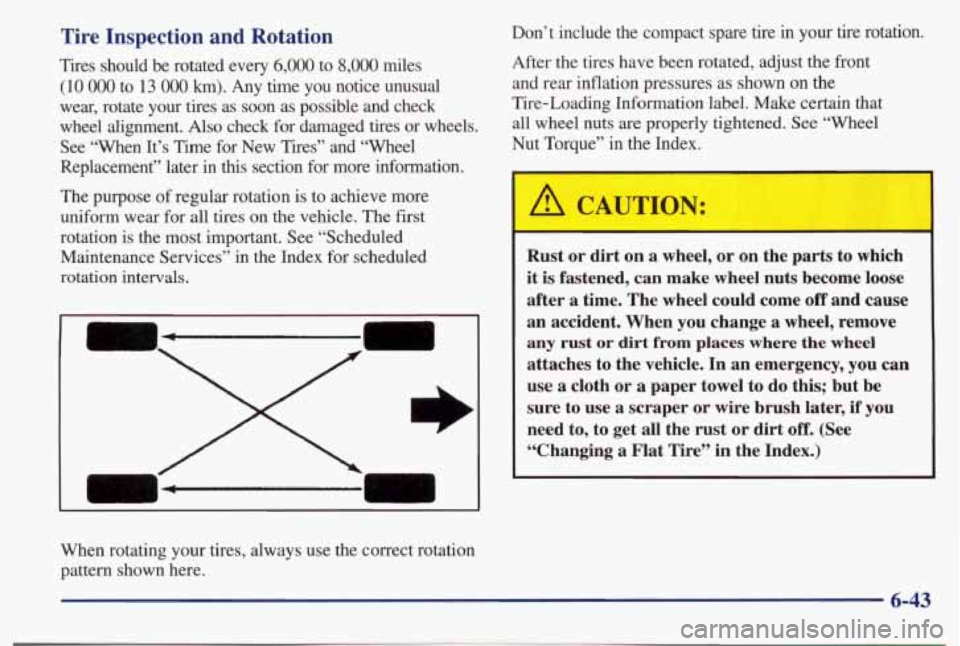
Tire Inspection and Rotation
Tires should be rotated every 6,000 to 8,000 miles
(10 OOO to 13 OOO km). Any time you notice unusual
wear, rotate your tires as soon as possible and check
wheel alignment.
Also check for damaged tires or wheels.
See “When It’s Time for New Tires” and “Wheel
Replacement” later in
this section for more information.
The purpose of regular rotation is to achieve more
uniform wear for all tires on the vehicle. The first
rotation is the most important. See “Scheduled Maintenance Services” in the Index for scheduled
rotation intervals.
m4
Don’t include the compact spare tire in your tire rotation.
After the tires have been rotated, adjust the front
and rear inflation pressures as shown
on the
Tire-Loading Information label. Make certain that all wheel nuts
are properly tightened. See “Wheel
Nut Torque” in the Index.
A CAUTION:
Rust or dirt on a wheel, or on the parts to which
it is fastened, can make wheel nuts become loose
after a time. The wheel could come
off and cause
an accident. When you change a wheel, remove
any rust or dirt from places where the wheel
attaches to the vehicle. In an emergency, you can
use a cloth or
a paper towel to do this; but be
sure to use a scraper or wire brush later,
if you
need to, to get all the rust or dirt
off. (See
“Changing a Flat Tire” in the Index.)
I
When rotating your tires, always use the correct rotation
pattern shown here.
6-43
Page 350 of 395
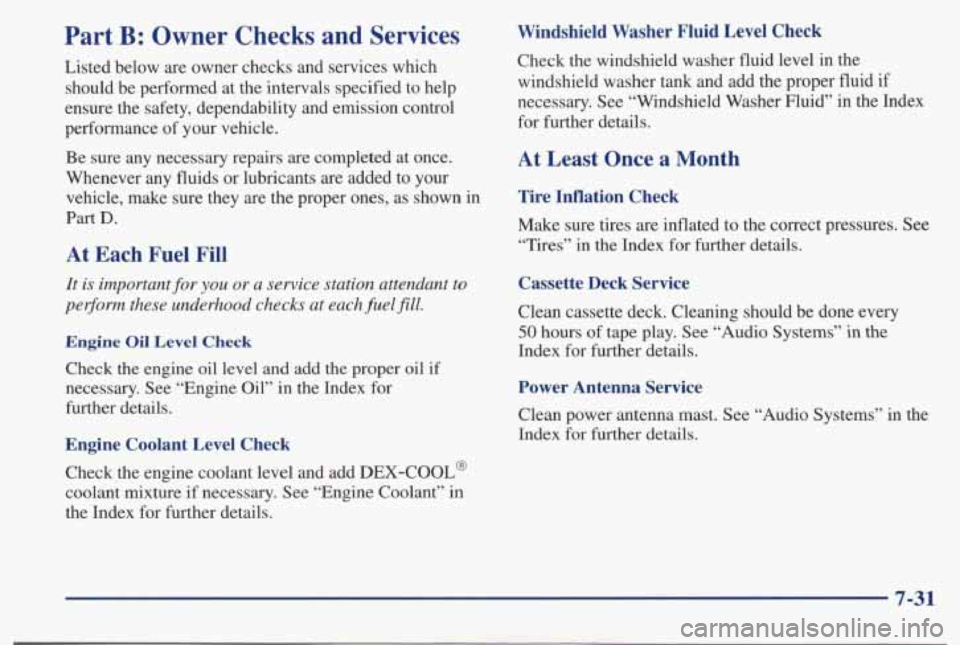
Part B: Owner Checks and Services
Listed below are owner checks and services which should be performed at the intervals specified to help
ensure the safety, dependability and emission control
performance of your vehicle.
Be sure any necessary repairs are completed at once.
Whenever any fluids or lubricants are added to your
vehicle, make sure they are
the proper ones, as shown in
Part D.
At Each Fuel Fill
It is important for you or a service station attendant to
pe~orm these underhood checks at each fuel
fill.
Engine Oil Level Check
Check the engine oil level and add the proper oil if
necessary. See “Engine Oil”
in the Index for
further details.
Engine Coolant Level Check
Check the engine coolant level and add DEX-COOL@
coolant mixture if necessary. See “Engine Coolant” in
the Index for further details.
Windshield Washer Fluid Level Check
Check the windshield washer fluid level in the
windshield washer tank and add the proper fluid
if
necessary. See “Windshield Washer Fluid” in the Index
for further details.
At Least Once a Month
Tire Inflation Check
Make sure tires are inflated to the correct pressures. See
“Tires” in the Index for further details.
Cassette Deck Service
Clean cassette deck. Cleaning should be done every
50 hours of tape play. See “Audio Systems” in the
Index for further details.
Power Antenna Service
Clean power antenna mast. See “Audio Systems” in the
Index for further details.
7-31
Page 378 of 395
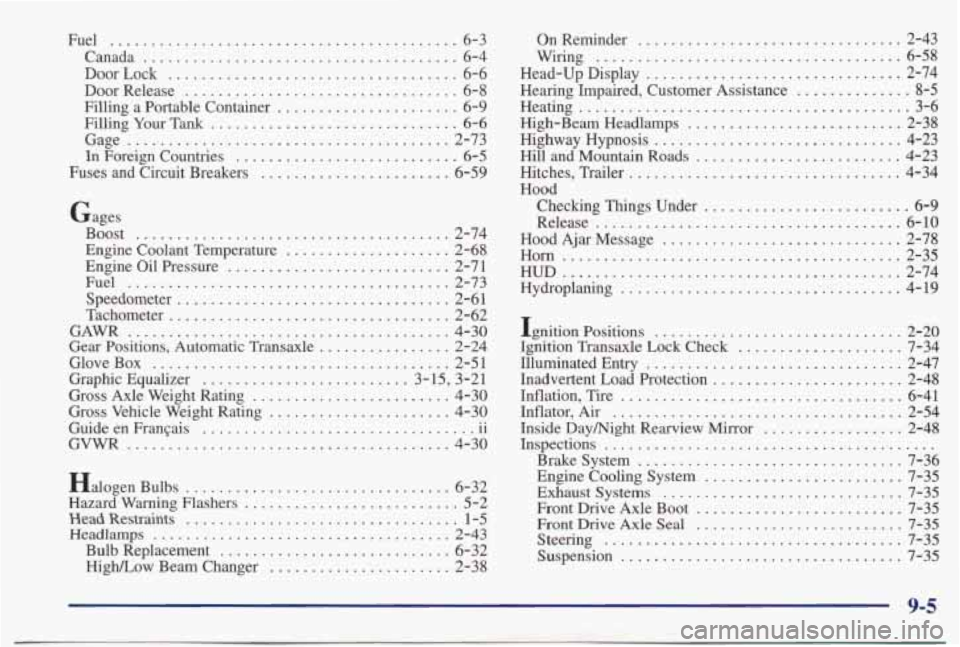
Fuel .......................................... 6-3
Canada
...................................... 6-4
Door Lock
................................... 6-6
Door Release
................................. 6-8
Filling a Portable Container
...................... 6-9
Filling
Your Tank .............................. 6-6
Gage ....................................... 2-73
In Foreign Countries ........................... 6-5
Fuses and Circuit Breakers ....................... 6-59
Gages Boost
.................................... 2-74
Engine Coolant Temperature
.................... 2-68
Engine Oil Pressure
........................... 2-71
Fuel
....................................... 2-73
Speedometer
................................. 2-6 1
Tachometer
.................................. 2-62
GAWR
....................................... 4-30
Gear Positions, Automatic Transaxle
................ 2-24
GloveBox
.................................... 2-51
Graphic Equalizer
......................... 3-15, 3-21
Gross Axle Weight Rating
........................ 4-30
Gross Vehicle Weight Rating
...................... 4-30
Guide en Franpis 11
GVWR ......... .................... 4-30
.. .................................
Halogen Bulbs ................................ 6-32 ...
Haadwarning Flashers .......................... 5-2
Head Restraints ................................. 1-5
Headlamps
.................................... 2-43
Bulb Replacement
............................ 6-32
High/Low Beam Changer
...................... 2-38 On Reminder
................................ 2-43
Wiring
..................................... 6-58
Head-Up Display
............................... 2-74
Hearing Impaired. Customer Assistance
.............. 8-5
High-Beam Headlamps .......................... 2-38
Highway Hypnosis
.............................. 4-23
Hill and Mountain Roads ......................... 4-23
Hitches. Trailer ................................. 4-34
Hood Checking Things Under
......................... 6-9
Release
..................................... 6-10
Hood Ajar Message
............................. 2-78
Horn
......................................... 2-35
HUD ......................................... 2-74
Hydroplaning
.... ..................... 4-19
Ignition Positions
.............................. 2-20
Ignition Transaxle Lock Check
.................... 7-34
Illuminated Entry
............................... 2-47
Inadvertent Load Protection
....................... 2-48
Inflation. Tire
.................................. 6-41
Inflator. Air
................................... 2-54
Inside Daymight Rearview
Mirror ................. 2-48
Brakesystem ................................ 7-36
Engine Cooling System
........................ 7-35
Exhaust Systems
............................. 7-35
Front Drive Axle Boot
......................... 7-35
FrontDriveAxleSeal
......................... 7-35
Steering
.................................... 7-35
Suspension
.................................. 7-35
Heating
........................................ 3-6
Inspections
........................................
9-5
Page 383 of 395
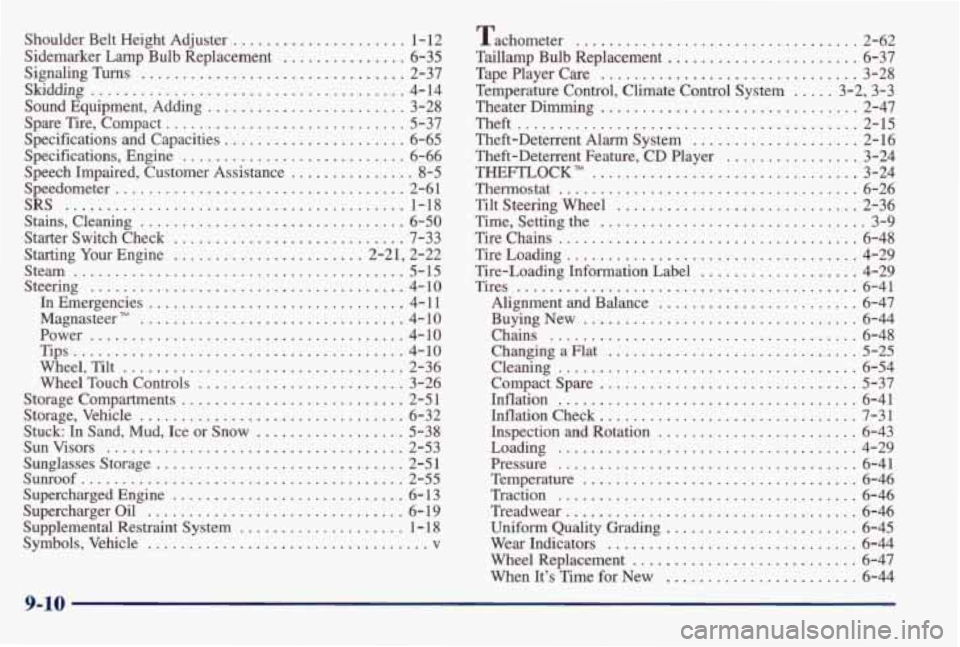
Shoulder Belt Height Adjuster ..................... 1-12
Sidemarker Lamp Bulb Replacement
............... 6-35
Signaling Turns
................................ 2-37
Skidding ...................................... 4-14
Sound Equipment. Adding
........................ 3-28
Spare Tire. Compact
............................. 5-37
Specifications and Capacities
...................... 6-65
Specifications. Engine
........................... 6-66
Speech Impaired. Customer Assistance
............... 8-5
Speedometer ................................... 2-61
SRS ......................................... 1-18
Stains. Cleaning
................................ 6-50
Starter Switch Check
............................ 7-33
Starting
Your Engine ....................... 2-21. 2-22
Steam
........................................ 5-15
Steering
...................................... 4-10
In Emergencies
............................... 4- 1 1
Magnasteer
TM ................................ 4- 10
Power
...................................... 4-10
Tips
........................................ 4-10
Wheel. Tilt
.................................. 2-36
Wheel Touch Controls
......................... 3-26
Storage Compartments
........................... 2-5 1
Storage. Vehicle
................................ 6-32
Stuck:
In Sand. Mud. Ice or Snow .................. 5-38
Sun Visors .................................... 2-53
Sunglasses Storage
.............................. 2-5 1
Sunroof ....................................... 2-55
Supercharged Engine ............................ 6- 13
Supercharger Oil
............................... 6- 19
Symbols. Vehicle .................................. v
Supplemental Restraint System .................... 1 - 18 Tachometer
.................................. 2-62
Taillamp Bulb Replacement
....................... 6-37
Tape Player Care
............................... 3-28
Temperature Control. Climate Control System
..... 3.2. 3.3
Theater Dimming ............................... 2-47
Theft
......................................... 2-15
Theft-Deterrent
Alarm System .................... 2-16
Theft-Deterrent Feature. CD Player
................ 3-24
THEFTLOCK
TM ................................ 3-24
Thermostat
.................................... 6-26
Tilt Steering Wheel
............................. 2-36
Time. Setting
the ................................ 3-9
Tire Chains
.................................... 6-48
Tirehading
................................... 4-29
Tire-Loading Information Label
................... 4-29
Tires ......................................... 6-41
Alignment and Balance
........................ 6-47
Buying New
................................. 6-44
Chains ..................................... 6-48
Changing a Flat
.............................. 5-25
Cleaning .................................... 6-54
Compact Spare
............................... 5-37
Inflation
.................................... 6-41
Inflationcheck
............................... 7-31
Inspection and Rotation
........................ 6-43
Loading
.................................... 4-29
Pressure
..................................... 6-41
Temperature
................................. 6-46
Traction
.................................... 6-46
Treadwe
ar ................................... 6-46
Wear Indicators
.............................. 6-44
Wheel Replacement
........................... 6-47
When It’s Time for New
....................... 6-44
Uniform Quality Grading ....................... 6-45
9-10